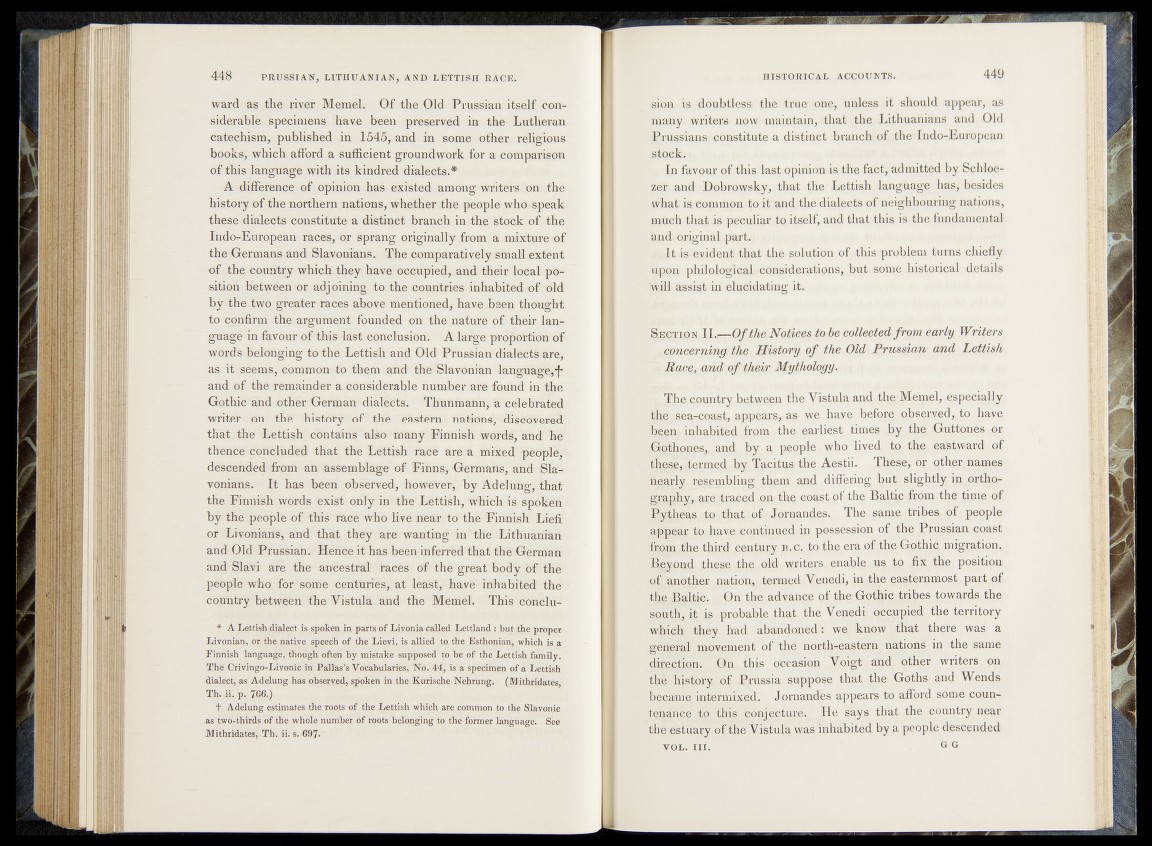
ward as the river Memel. Of the Old Prussian itself considerable
specimens have been preserved in the Lutheran
catechism, published in 1545, and in some other religious
books, which afford a sufficient groundwork for a comparison
of this language with its kindred dialects.*
A difference of opinion has existed among writers on the
history of the northern nations, whether the people wvho speak
these dialects constitute a distinct branch in the stock of the
Indo-European races, or sprang originally from a mixture of
the Germans and Slavonians. The comparatively small extent
of the country which they have occupied, and their local position
between or adjoining to the countries inhabited?©! old
by the two greater races above mentioned, have been thought
to confirm the argument founded on the nature of their language
in favour of this-last conclusion. A large proportion of
words belonging to the Lettish and Old Prussiaiï^dihlë^ are,
ns it seems, common to them and the^lavonian language,-f*
and of the remainder a considerable number are found in the
Gothic and other German diaïéctè. Thunmann, a celebrated
writer on the history of the eastern natiöns>r7dfécöveréH‘’
that the Lettish contains also many Finnisi wofds, and he
thence concluded that the Lettish raee are a mixed people,
descended from an assemblage of Finns, Germans,'and Slavonians.
I t has been observed, however* by Adëlung, that
the Finnish words exist only in the'Lettish, which i# spoken
by the people of this race who live near to '•the Finnish Lieff'
or Livonians, and that they are wanting in ' the Lithuanian
and Old Prussian. Hëfice it has been inferred that thè Germfa'n
and Slavi are the ancestral races of the grCat body tl! the
people who for some centuries, at least, have inhabited the
country between the Vistula and the Memel. This donclu-
* A Lettish dialect is spoken in parts of Livonia called Lettlau.d : but the proper
Livonian, or.-the native speech of the Lievi, is allied to the Esthonian, which is a
^Finnish languagè, though often by mistake supposed to be of the Lettish family.
Thè Crivingo-Livonic inf Pallas’s Vocabularies,'No. 44, is a specimen of a Lettish
dialect, as Adelung has observed, spoken in the Kurisehe Nehrung. (Mithridates
Th. ii, p. 766.)
t Adelung estimates the roots of the Lettish which are common to the Slavonic
as two-thirds of the whole number of roots belonging to the former language. See
Mithridates, Th. fi. S. 697*" '
s-ion is • doubtless. the true : one, unless it should appear, as
many writers now maintain,, that the Lithuanians and Old
PjrussianSfGonstitute^a.distinct branch of the Indo-European
gtpG.teyu
In favour <jf this lasjsopinipn is the fact, admitted bySchloe-
zen and Dobrowsky,; that Lettish, language, has, besides
what is,-common to it and the dialects.of neighbouring nations,
much that is peculiar toatself, and that, this is the fundamental
and original part.
It is evident that thp.ss$kition of this problem turns chiefly-
upon philological ■ considerations, but some historical details
’will assistlin elucidating it.
§ ^ qtion I L r ^O f the Notices to he collected from early Writers
^concerning the History o f the Old Prussian and Lettish
T«. Race, and o f their Mythology. 1
i. "rhje:country bet^gpp the Vistula and the Memel, especially
thg|..sjaa.Tpramt. appears.? as we have befor^obseryed^ ^o have
been inhabited from the earliest times^by the Guftones or
.Gotjiojies^ and by a people^ who lived^ to the eastward of
these,,termed,-by Tacitus the Aestii. These, or other names
nj^ply^re^mbling them and differing but slightly in ortho-
gfaphy,, %re;traced on the co^st of thç Baÿjp from the time of
Pytb;eas, to th a t. of Jprnandçs. The tribes,,pf ‘, people
appear tp hav.cçontirmpd pi ppss,fe§g^i Prussian coasf
from .the third century u ito the^era ^f the- Gpthiçl4ipigratio,g»
Esmond the.se the old writer^, .enable, u s tto fix the position
oft another nation,, termed Venejii, in the easternmost part of
tbç, Baltic. , £)n the advance of the Gothic tribes upwards the
south, it is probable that the Vepedi,-occupied ,the territory
which they had abandoned : we know that th&e was a
general movement of thé north-eastern nation^ in the same
directions On this b&easibn Voigt and other writers on
the.'history of Prussia suppose that the Goths and Wends
became intermixed. Jornandes appears to afford some coun-
te n a n ^ to this conjecture. He says that th^ôountry near
the estuary of the Vistula was inhabited by a people descended
VOL. III. GG